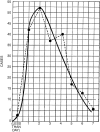Model answers or trivial pursuits? The role of mathematical models in influenza pandemic preparedness planning
- PMID: 19432634
- PMCID: PMC4634556
- DOI: 10.1111/j.1750-2659.2007.00008.x
Model answers or trivial pursuits? The role of mathematical models in influenza pandemic preparedness planning
Abstract
The panzootic of H5N1 influenza in birds has raised concerns that the virus will mutate to spread more readily in people, leading to a human pandemic. Mathematical models have been used to interpret past pandemics and outbreaks, and to thus model possible future pandemic scenarios and interventions. We review historical influenza outbreak and transmission data, and discuss the way in which modellers have used such sources to inform model structure and assumptions. We suggest that urban attack rates in the 1918-1919 pandemic were constrained by prior immunity, that R(0) for influenza is higher than often assumed, and that control of any future pandemic could be difficult in the absence of significant prior immunity. In future, modelling assumptions, parameter estimates and conclusions should be tested against as many relevant data sets as possible. To this end, we encourage researchers to access FluWeb, an on-line influenza database of historical pandemics and outbreaks.
Figures





Similar articles
-
Strategic analysis on responding human avian flu and flu pandemic in China.Biomed Environ Sci. 2006 Apr;19(2):158-61. Biomed Environ Sci. 2006. PMID: 16827190 No abstract available.
-
Pandemic influenza preparedness.MedGenMed. 2006 Oct 13;8(4):11. MedGenMed. 2006. PMID: 17415294 Free PMC article. No abstract available.
-
Preparedness for highly pathogenic avian influenza pandemic in Africa.Emerg Infect Dis. 2007 Oct;13(10):1453-8. doi: 10.3201/eid1310.070400. Emerg Infect Dis. 2007. PMID: 18257986 Free PMC article.
-
Highly pathogenic avian influenza A/H5N1-update and overview of 2006.Euro Surveill. 2006 Dec 21;11(12):E061221.1. doi: 10.2807/esw.11.51.03098-en. Euro Surveill. 2006. PMID: 17213569 Review. No abstract available.
-
Avian influenza--a pandemic waiting to happen?J Microbiol Immunol Infect. 2006 Feb;39(1):4-10. J Microbiol Immunol Infect. 2006. PMID: 16440117 Review.
Cited by
-
Anticipating the prevalence of avian influenza subtypes H9 and H5 in live-bird markets.PLoS One. 2013;8(2):e56157. doi: 10.1371/journal.pone.0056157. Epub 2013 Feb 7. PLoS One. 2013. PMID: 23409145 Free PMC article.
-
A review of mathematical models of influenza A infections within a host or cell culture: lessons learned and challenges ahead.BMC Public Health. 2011 Feb 25;11 Suppl 1(Suppl 1):S7. doi: 10.1186/1471-2458-11-S1-S7. BMC Public Health. 2011. PMID: 21356136 Free PMC article.
-
Respiratory pandemics, urban planning and design: A multidisciplinary rapid review of the literature.Cities. 2022 Aug;127:103767. doi: 10.1016/j.cities.2022.103767. Epub 2022 May 30. Cities. 2022. PMID: 35663146 Free PMC article.
-
Dynamics of Zika virus outbreaks: an overview of mathematical modeling approaches.PeerJ. 2018 Mar 22;6:e4526. doi: 10.7717/peerj.4526. eCollection 2018. PeerJ. 2018. PMID: 29593941 Free PMC article.
-
Infectious disease pandemic planning and response: Incorporating decision analysis.PLoS Med. 2020 Jan 9;17(1):e1003018. doi: 10.1371/journal.pmed.1003018. eCollection 2020 Jan. PLoS Med. 2020. PMID: 31917786 Free PMC article. Review.
References
-
- Monto AS. The threat of an avian influenza pandemic. N Engl J Med 2005;352:323–325. - PubMed
-
- Hatta M, Kawaoka Y. The continued pandemic threat posed by avian influenza viruses in Hong Kong. Trends Microbiol 2002;10:340–344. - PubMed
-
- Ducatez MF, Olinger CM, Owoade AA et al. Avian flu: multiple introductions of H5N1 in Nigeria. Nature 2006;442:37. - PubMed
-
- Update: WHO‐confirmed human cases of avian influenza A (H5N1) infection, 25 November 2003–24 November 2006. Wkly Epidemiol Rec 2007;82:41–47. - PubMed
-
- Katz JM, Lim W, Bridges CB et al. Antibody response in individuals infected with avian influenza A (H5N1) viruses and detection of anti‐H5 antibody among household and social contacts. J Infect Dis 1999;180:1763–1770. - PubMed
Publication types
MeSH terms
Substances
LinkOut - more resources
Full Text Sources
Medical
Miscellaneous

